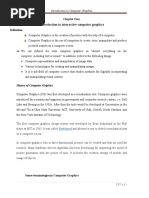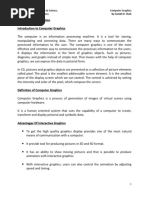Computer Graphics: Week 2
Uploaded by
Fawad Ali Sher KhanComputer Graphics: Week 2
Uploaded by
Fawad Ali Sher KhanComputer Graphics
Week 2
The study of computer graphics is a sub-field of computer science which studies methods for digitally synthesizing and manipulating visual content. Although the term often refers to threedimensional computer graphics, it also encompasses two-dimensional graphics and image processing.
As an academic discipline, computer graphics studies the manipulation of visual and geometric information using computational techniques. It focuses on the mathematical and computational foundations of image generation and processing rather than purely aesthetic issues.
Simple or
Passive Computer Graphics
Interactive or
Active computer graphics
Control
Passive
Communication
No Control
Control
Active
Interaction
One Way Communication No Interaction between User and Hardware
Communication
Dynamic nature
Interaction
2-Way Communication High bandwidth user interaction
Earlier supported Motion & Updating
No facility
Modern Applications Motion & Updation
2-D, 3-D Transformations
In digital imaging, a pixel, or pel, (picture element) is a single point in a raster image. the smallest addressable screen element in a display device; it is the smallest unit of picture that can be represented or controlled Each pixel has its own address. The address of a pixel corresponds to its coordinates. Pixels are normally arranged in a twodimensional grid, and are often represented using dots or squares.
In computer graphics, a bitmap or pixmap is a type of memory organization or image file format used to store digital images. The term bitmap comes from the computer programming terminology, meaning just a map of bits, a spatially mapped array of bits.
The display resolution of a digital television or display device is the number of distinct pixels in each dimension that can be displayed. It is usually quoted as width height, with the units in pixels: for example, "1024x768" means the width is 1024 pixels and the height is 768 pixels.
You might also like
- Unit-1 Overview of Computer Graphics (E-Next - In)No ratings yetUnit-1 Overview of Computer Graphics (E-Next - In)61 pages
- Computer Graphics: Sunanda Yadav Biswajit Panda Shasi Bhusan Beena Kumari Sanjeet Kumar Neha Sahay Sec-CNo ratings yetComputer Graphics: Sunanda Yadav Biswajit Panda Shasi Bhusan Beena Kumari Sanjeet Kumar Neha Sahay Sec-C32 pages
- COMPUTER GRAPHICS AND MULTIMEDIA Unit 1No ratings yetCOMPUTER GRAPHICS AND MULTIMEDIA Unit 163 pages
- TOPIC I II III Introduction Computer GraphicsNo ratings yetTOPIC I II III Introduction Computer Graphics14 pages
- Unit 1 Basics of Computer Graphics - FinalNo ratings yetUnit 1 Basics of Computer Graphics - Final22 pages
- Unit 1-Introduction to CG and Graphics SystemNo ratings yetUnit 1-Introduction to CG and Graphics System13 pages
- IS 246: Principles of Computer GraphicsNo ratings yetIS 246: Principles of Computer Graphics27 pages
- 1.1. Image and Object:-: The DefinitionsNo ratings yet1.1. Image and Object:-: The Definitions18 pages
- Chapter 2 - Overview of Graphics SystemsNo ratings yetChapter 2 - Overview of Graphics Systems37 pages
- Unit - 1 Introduction To Computer Graphics Unit-01/Lecture-01No ratings yetUnit - 1 Introduction To Computer Graphics Unit-01/Lecture-0130 pages
- Subject - Computer Graphics (22318) Unit 1 (Topic 1) - by Nitin Pawar SirNo ratings yetSubject - Computer Graphics (22318) Unit 1 (Topic 1) - by Nitin Pawar Sir27 pages
- Lec 01_02 Introduction to Computer GraphicsNo ratings yetLec 01_02 Introduction to Computer Graphics73 pages
- Introduction To Interactive Computer Graphics: Chapter One: DefinitionNo ratings yetIntroduction To Interactive Computer Graphics: Chapter One: Definition6 pages
- Computer Graphics UNIT-1 Notes 23 sep 2024No ratings yetComputer Graphics UNIT-1 Notes 23 sep 202418 pages
- DC105 Module1 Lesson1 - Graphics and VisualizationNo ratings yetDC105 Module1 Lesson1 - Graphics and Visualization15 pages
- Rendering Computer Graphics: Exploring Visual Realism: Insights into Computer GraphicsFrom EverandRendering Computer Graphics: Exploring Visual Realism: Insights into Computer GraphicsNo ratings yet
- Raster Graphics: Understanding the Foundations of Raster Graphics in Computer VisionFrom EverandRaster Graphics: Understanding the Foundations of Raster Graphics in Computer VisionNo ratings yet
- Abbreviation Derivation of AbbreviationNo ratings yetAbbreviation Derivation of Abbreviation37 pages
- International High Achiever Scholarships: UndergraduateNo ratings yetInternational High Achiever Scholarships: Undergraduate1 page
- HTTP WWW - Google.com - PK Url Q HTTP WWW - Eazynotes.com Notes Computer-Graphics Algorithms Mid-point-circle-AlgorithmNo ratings yetHTTP WWW - Google.com - PK Url Q HTTP WWW - Eazynotes.com Notes Computer-Graphics Algorithms Mid-point-circle-Algorithm1 page
- CCTV System Selection Fundamentals: "What To Look For When Planning A Camera System "No ratings yetCCTV System Selection Fundamentals: "What To Look For When Planning A Camera System "17 pages
- Transport Layer Identification of P2P TrafficNo ratings yetTransport Layer Identification of P2P Traffic14 pages
- Transport Layer Identification of P2P TrafficNo ratings yetTransport Layer Identification of P2P Traffic14 pages
- Unit-1 Overview of Computer Graphics (E-Next - In)Unit-1 Overview of Computer Graphics (E-Next - In)
- Computer Graphics: Sunanda Yadav Biswajit Panda Shasi Bhusan Beena Kumari Sanjeet Kumar Neha Sahay Sec-CComputer Graphics: Sunanda Yadav Biswajit Panda Shasi Bhusan Beena Kumari Sanjeet Kumar Neha Sahay Sec-C
- Unit - 1 Introduction To Computer Graphics Unit-01/Lecture-01Unit - 1 Introduction To Computer Graphics Unit-01/Lecture-01
- Subject - Computer Graphics (22318) Unit 1 (Topic 1) - by Nitin Pawar SirSubject - Computer Graphics (22318) Unit 1 (Topic 1) - by Nitin Pawar Sir
- Introduction To Interactive Computer Graphics: Chapter One: DefinitionIntroduction To Interactive Computer Graphics: Chapter One: Definition
- DC105 Module1 Lesson1 - Graphics and VisualizationDC105 Module1 Lesson1 - Graphics and Visualization
- Rendering Computer Graphics: Exploring Visual Realism: Insights into Computer GraphicsFrom EverandRendering Computer Graphics: Exploring Visual Realism: Insights into Computer Graphics
- Raster Graphics: Understanding the Foundations of Raster Graphics in Computer VisionFrom EverandRaster Graphics: Understanding the Foundations of Raster Graphics in Computer Vision
- International High Achiever Scholarships: UndergraduateInternational High Achiever Scholarships: Undergraduate
- HTTP WWW - Google.com - PK Url Q HTTP WWW - Eazynotes.com Notes Computer-Graphics Algorithms Mid-point-circle-AlgorithmHTTP WWW - Google.com - PK Url Q HTTP WWW - Eazynotes.com Notes Computer-Graphics Algorithms Mid-point-circle-Algorithm
- CCTV System Selection Fundamentals: "What To Look For When Planning A Camera System "CCTV System Selection Fundamentals: "What To Look For When Planning A Camera System "







































































